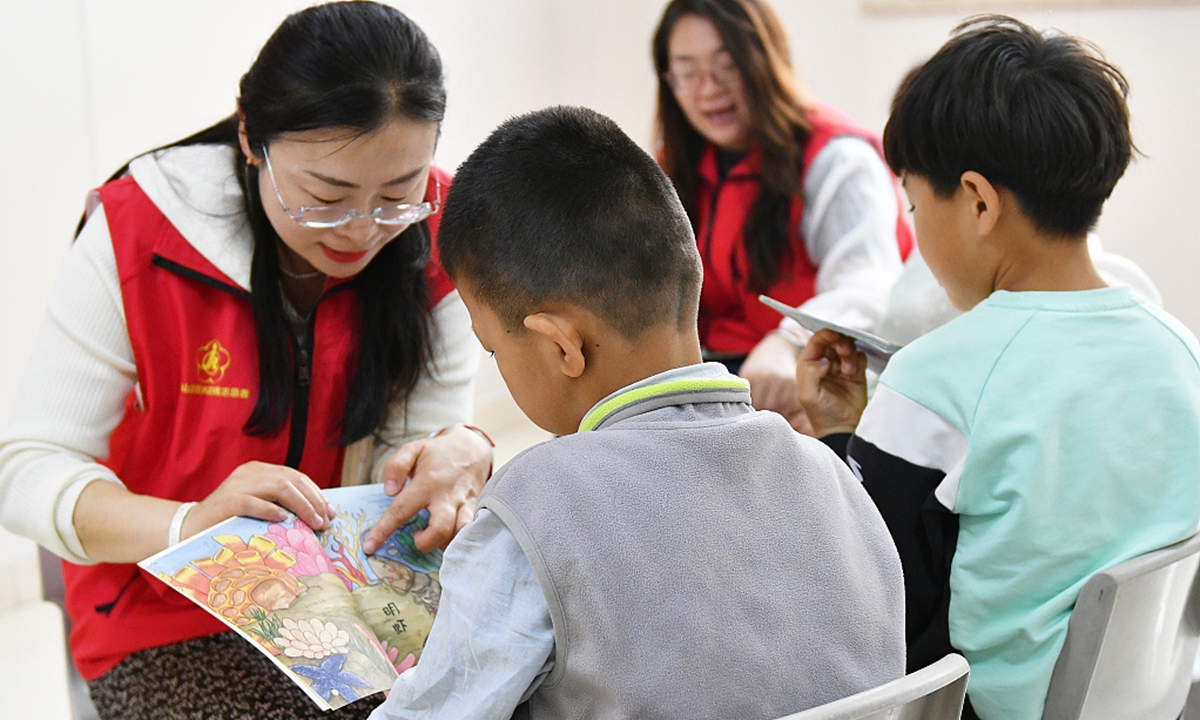With International Children's Day approaching, experts have gathered for training on the latest diagnostic criteria of autism spectrum disorder (ASD). Given the uncertainty surrounding the prevalence of ASD in children affected, specialists stressed the importance of early diagnoses to achieve better outcomes.
It is estimated that worldwide about 1 in 100 children has autism, according to a systematic review update released in March 2022.

Volunteers help autistic children read picture books at a Children's Rehabilitation Center in Yantai, East China's Shandong Province, on May 17, 2024. Photo: VCG
China is no exception to the situation. Terence Ma Tin Shu, an educational psychologist listed in the accredited register, practicing in the Hong Kong Special Administrative Region and the Chinese mainland, told the Global Times that it is important to implement early intervention in dealing with autism.
John (pseudonym) had not yet spoken his first word by age 2, a developmental milestone that concerned his parents deeply. While his peers were beginning to form simple sentences, John communicated primarily through gestures. He also showed a noticeable disinterest in social interactions.
John's parents noticed behaviors that appeared different from those of his peers. At family gatherings, while other children played together, John preferred to play alone, focusing intently on toys and engaging in repetitive actions.
They sought professional help and quickly understood that identifying the issue was the first step toward helping their son. After proper diagnoses, John was enrolled in an early intervention program specifically designed for children with ASD. The importance of intervening during early childhood cannot be overstressed, Ma noted.
Jia Meixiang, a chief physician with the Peking University Sixth Hospital, shared with the Global Times that it may be difficult to obtain a complete overview of how many children are suffering from ASD in China. Indeed, despite some regional data being available in big cities such as Shanghai, the overall national statistics are not available.
Jia, one of the instructors in the new diagnostic criteria training and the former president of Beijing Association for the Rehabilitation of Autistic Children, finds it important to get the diagnostic work carried out before the age of 4.
Take toys sharing as an example. Jia explained that children who might suffer from ASD, they may not be willing to share their toys with their peers. They may spend a significant amount of time focused on spinning objects and appear to be very stubborn about some behavioral patterns.
"The younger these children are, the less concept of self they have forged, so it is easier to make early interventions and these are more likely to be effective," Jia pointed out.
After months of intervention, John started to use words and gradually began engaging in simple conversations. His interest in others grew and he began to make eye contact with others and participate in group activities at his preschool.
Jia pointed out a fundamental difference between the original Childhood Autism Rating Scale (CARS) with CARS 2, an updated version of the assistive diagnostic tool. Previously, the diagnostic criteria were ranked in four levels, while in CARS 2, three medium levels have been added in between two major levels, bringing the number of categories in which criteria are divided to seven. This new and more detailed diagnostic tool has been designed to improve the effectiveness and precision of the diagnostic process.
"With CARS 2, professionals can better avoid missed diagnosis, so that more children could be identified in earlier stages and start proper training," Jia said.
For Lin (pseudonym), a 4-year-old boy, the initial use of this CARS 2 revealed specific areas where intervention was needed, particularly in enhancing his ability to engage socially and process sensory information effectively, Ma said.
Wrapping up this case study, Ma concluded that it is crucial to recognize that the effective approach of standardized psychometric assessment tools goes beyond simple task execution. Professionals conducting these assessments must undergo rigorous standardized training and practicum to become eligible users.
Jia said it is important to ensure that the family accompany to children who suffer from ASD. She encourages parents to spend more time with their children, especially during meals, rest and play time.
In a bustling primary school, 7-year-old Mia (pseudonym), was helped through an incentive system based on a transparent marble jar. According to the system, each instance of positive behavior, such as participating attentively in group activities, following instructions promptly, or assisting a classmate, would earn her a marble.
Mia was more engaged during lessons and became more cooperative during group activities. Additionally, her self-assessment skills improved, and she became more adept at understanding and regulating her behavior.
This support system has been lately applied in more classes and families, Ma explained and this strategy not only supports children with specific needs like ASD but also fosters a broader educational environment where all children can thrive, he added.
CASR 2 is developing its Chinese characteristics. Jia said that her team has been working for more than two years to get a tool suite from WPS, a US company, to customize and personalize according to cultural and social background.
"We are using innovative ways to make the toolkit even more standardized," she said.
Every child on the autism spectrum has unique needs and responds differently to interventions. There is no "one-size-fits-all" method, Ma explained.
Ethan (pseudonym), 11, became better at using words to describe his feelings and at employing relaxation techniques when he felt overwhelmed. The effective approach for him turned out to be puppets that allowed Ethan to step into a world where learning was subtly woven into fun activities.




